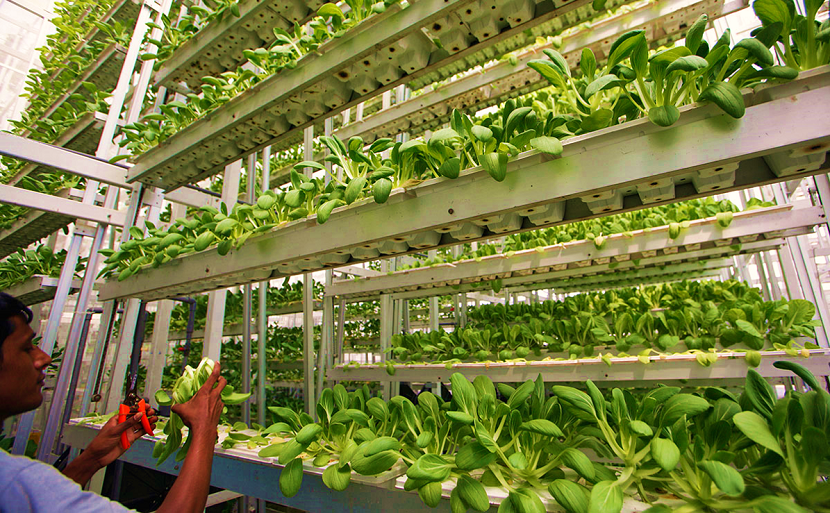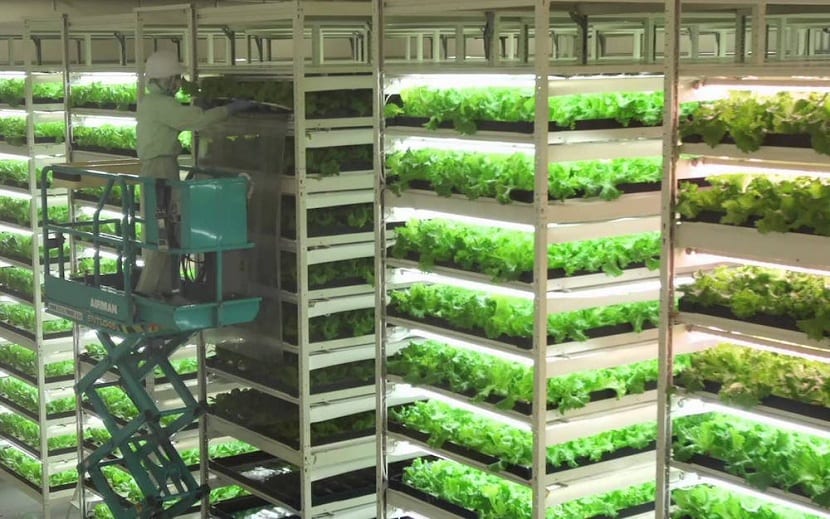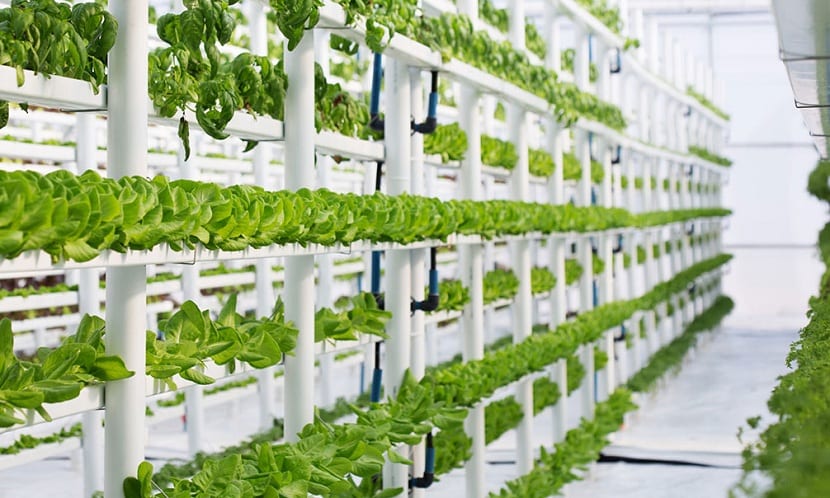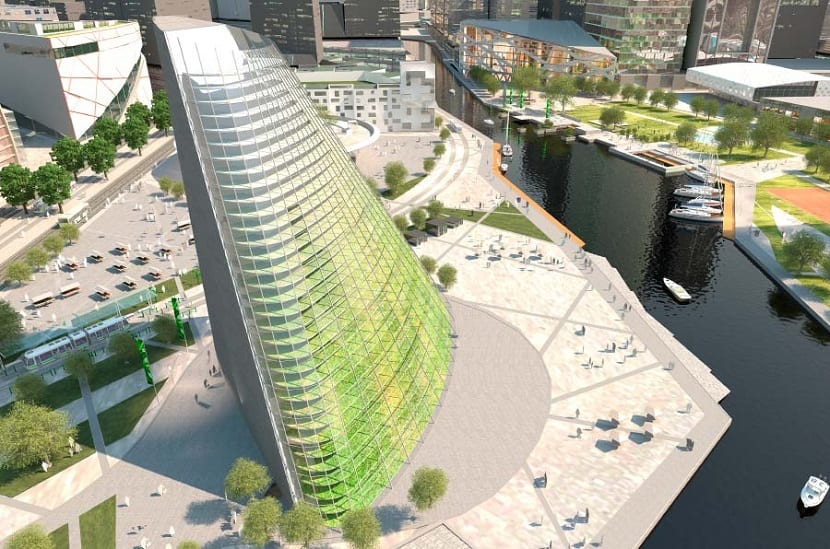
Our planet has 33% of all the soil in the world degraded by erosion. Erosion that is increased when intensive agriculture overexploits the capacities of the soil to improve crop production. The future that awaits us in terms of agriculture and soil quality is no better than it is now. It is expected that by 2050 10% of all current agricultural yields will be lost due to erosion. Faced with this situation we have one hope: vertical farming.
What is vertical farming and what is it about? We will tell you all this in this article.
What is vertical farming

Today there is not much land that has fertile crops on its own without the help of chemicals. Madrid is home to one of the largest vegetation factories in all of Spain. It is a vertical farming center. And it is that vertical agriculture is a non-traditional approach to agriculture that allows crops to be planted inside multi-story buildings. The bigger and taller the building, the more crops can be stored. These buildings function similar to that of a greenhouse. It is about conditioning the environmental variables to the optimization in the growth of the crops and the increase of the production.
The buildings dedicated to vertical agriculture are usually up to skyscrapers with a large dimension and use of modern technology such as Hydroponics to be able to grow the plants. Despite what you may think of a person who works producing crops, the suit to work in these places is a lab coat. With the appearance of a surgeon, specialists in vertical crops work to reduce the amount of soil exploited by intensive agriculture and improve so that the quality of the products is better and better.
To be able to enter the part of the vertical crops it is necessary to be disinfected first. Once the clothing is prepared, you enter the growing areas. In Madrid there are plant areas with 1000 square meters of plant, and 20 plants high. These buildings dedicated to vertical agriculture focus on growing tomatoes, chard, lettuce, etc. To replace the sun, they are used LED bulbs high quality to promote proper growth.
This type of agriculture is also known as indoor agriculture. Let's see the details.
Key features
Among the advantages that we find with the use of vertical agriculture we have:
- Less space is needed to be able to produce food. As the world population is growing more and more, there is much more demand for food. Therefore, the amount of fertile soil has been reduced and the rest is degraded. With these vertical farms, urban environments are used to plant and cultivate.
- LED technology is getting cheaper, so production also reduces your costs. In this way, although crops cannot take advantage of sunlight, they can grow cheaply.
- This market is growing in economies such as those of Asia and the Pacific.
- The consumer is more aware of the environment. Therefore, the demand for foods with fewer chemicals is increasingly high. Indoor farms make it possible to produce local products and reduce transport distances and, therefore, air pollution.
The truth is that production in vertical agriculture is capable of increasing production between 40% and 100% compared to conventional. In this way, less water is used, less agrochemicals and it does not require as much labor. Although it is true that the workforce must be more qualified. However, it is not a problem.
The rest of conventional agriculture can be used in sustainable or conservation agriculture. In this way, we will not be taking the use of the land so that it ends up being neglected and deforested. This is what happens with the phenomenon known as rural exodus.
More homogeneous harvests

Given the advantages obtained from vertical agriculture, the sowings can be almost completely automated. This makes it more sustainable since the harvests obtained are more homogeneous. Food waste is reduced and it is allowed to have several crops a year of the same product.
This form of cultivation also allows us not depend on external conditions such as the weather and the weather at all times. Many crops are destroyed or degraded in severe storms. Inside the buildings they are protected from any adverse environmental conditions.
This type of agriculture also has a positive impact on the damage produced in natural ecosystems. For example, by not using as many pesticides, herbicides, nitrogen fertilizers and pesticides, neither the soil nor the groundwater is polluted. This has an impact on a better recovery of the soil after the growing season. In addition, if vertical crops do not use soil, it can be used for other uses such as forest land.
The ideal conditions offered by vertical farming allow faster growth of the crop. This will be expressed in a very different nutritional profile and will show improved organoleptic characteristics than those of the traditional crop.
European vertical farming
The possibility of being able to control the indoor climate of the crops makes it possible to have "vegetables a la carte". This can make them grow faster and improve the nutritional profile. For this technique to spread throughout Europe, it is important that the consumer has a good conception of this type of crop. Thus, it will also be possible to invest in the improvement of the peri-urban and urban agriculture technique.
The technology of indoor farms in Europe It allows to have harvests in just 30-40 days, when the normal thing outdoors is every 65 days.
As you can see, vertical farming is a good option to reduce the environmental impact on soils around the world. Hopefully their technology improves and they become more and more efficient.


Excellent all these advances in relation to a subject as delicate and vital as agriculture. I just hope that this type of technology is made available to those of us who do not have money for large investments. I really like the idea of this type of agriculture and I want to somehow become an ally of these initiatives to see how we can develop them in my country, Venezuela, where we have a deep food production crisis. I would like to know if there are organizations worldwide that can support us to support these proposals in my country, and what would be the minimum investment to start in a very modest way, what type of training is required, what type of infrastructure, materials, etc. If there is someone in Venezuela who is developing this type of agriculture, links, where to receive training online or in person, organizations that can finance this type of agriculture, etc. Please help me to give cause to these concerns and raise the flags of this beautiful agroecological initiative in Venezuela. I hope they support me and that my concern does not remain alone. Yours sincerely, Mr. Jose Luis Bustamante Whatsapp (+58 4128789187)